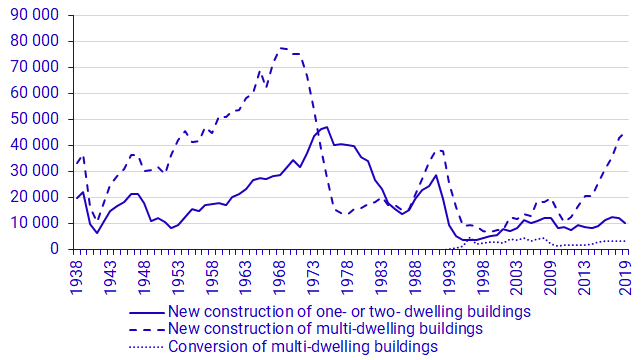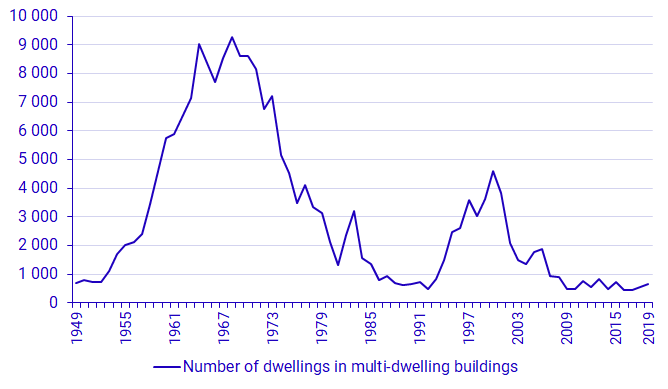Completed new construction, Conversion and demolition of multi-dwelling buildings 2019 – definitive figures
Increased numbers of new dwellings in multi-dwelling buildings
Statistical news from Statistics Sweden 2020-05-07 9.30
In 2019, 45 446 newly built dwellings in total were completed in multi-dwelling buildings. This is 6 percent more compared to last year.
In one-or two-dwelling buildings, an additional 10 213 dwellings were completed, which is slightly fewer than in 2018. In addition, 3 155 dwellings were completed through conversion of existing multi-dwelling buildings. As a result, there was an increase of 58 814 dwellings in total in 2019.

Most new dwellings per inhabitant in Uppsala County
In 10 out of 21 counties in Sweden, more dwellings were completed in 2019 than in the previous year. Around half of the completed dwellings are located in the three metropolitan areas.
In Uppsala County, there were 10.1 completed dwellings per 1 000 inhabitants, which is the largest number of completed dwellings per 1 000 inhabitants. In second place is Skåne County, with 6.6 completed dwellings per 1 000 inhabitants. Norrbotten County increased the most, and had 5.9 completed dwellings per 1 000 inhabitants, compared with 3.9 completed dwellings per 1 000 inhabitants a year ago. Värmland County and Dalarna County had 2.3 completed dwellings per 1 000 inhabitants, which was the lowest number of completed dwellings. The corresponding figure for the entire country was 5.4 completed dwellings per 1 000 inhabitants.
| County | Number of dwellings per 1 000 inhabitants |
|---|---|
| Blekinge county | 2.7 |
| Dalarnas county | 2.3 |
| Gotlands county | 4.6 |
| Gävleborgs county | 2.8 |
| Hallands county | 4.9 |
| Jämtlands county | 4.8 |
| Jönköpings county | 4.0 |
| Kalmar county | 4.4 |
| Kronobergs county | 4.5 |
| Norrbottens county | 5.9 |
| Skåne county | 6.6 |
| Stockholms county | 6.3 |
| Södermanlands county | 4.5 |
| Uppsala county | 10.1 |
| Värmlands county | 2.3 |
| Västerbottens county | 4.4 |
| Västernorrlands county | 2.4 |
| Västmanlands county | 4.5 |
| Västra Götalands county | 5.7 |
| Örebro county | 4.2 |
| Östergötlands county | 4.5 |
| Sweden | 5.4 |
Most new rented dwellings in multi-dwelling buildings
In 2019, most of the completed new construction of multi-dwelling buildings were rented dwellings; 53 percent were rented dwellings and 47 percent were tenant-owned. However, the type of tenure varies by region. In Stockholm, tenant-owned dwellings remain more common; as many as six in ten new dwellings in multi-dwelling buildings are tenant-owned. In Greater Malmö and outside the metropolitan areas, the proportions are reversed and approximately six in ten of newly constructed dwellings were rented.
| Share of Tenant-owned dwellings | Share of Rented dwellings | |
|---|---|---|
| Greater Stockholm | 61 | 39 |
| Greater Göteborg | 55 | 45 |
| Greater Malmö | 39 | 61 |
| Sweden excluding metropolitan areas | 38 | 62 |
| Sweden | 47 | 53 |
Tenant-owned dwellings are also completed in one- or two-dwelling buildings. From completion of only a few hundred dwellings yearly over a longer period, there has been an increase in recent years. In 2019, just over 2 300 newly constructed dwellings in one- or two-dwelling buildings were tenant-owned, which is more than one fifth of the one- or two-dwelling buildings that were completed. This is fewer than in 2018, when more than one fourth of the one- or two-dwelling buildings that were completed were tenant-owned.
Small dwellings are increasing more
The most common size of dwelling in multi-dwelling buildings that were completed was a dwelling with two rooms and kitchen; there were more than 16 700 dwellings of this size, which is more than one in three dwellings.
The number of small dwellings increased by 10 percent, which corresponds to more than 2 600 more dwellings that have two rooms or less were added during the year compared to unchanged levels for dwellings that have three rooms or more.
The average useful floor space for a dwelling is 58 square metres in new construction of multi-dwelling buildings and 145 square metres in one- or two-dwelling buildings.
Special housing
Among the new dwellings in multi-dwelling buildings, 6 418 were classified as special housing. Among those, 3 110 dwellings were designated for students and 2 682 dwellings for elderly or disabled persons.
Conversion of multi-dwelling buildings
In addition to the dwellings completed through new construction in 2019, 3 155 dwellings were completed through conversion of existing multi-dwelling buildings, which is about 10 percent less than in 2018. About 88 percent of those dwellings were formerly non-residential buildings that were converted into dwellings, and about 12 percent were formerly attics converted into dwellings.
Demolition of dwellings in multi-dwelling buildings
In 2019, demolition of 658 dwellings in multi-dwelling buildings was started. This is 100 dwellings more than in 2018, but still among the lowest numbers of demolished dwellings since the survey was first carried out in 1949.

Definitions and explanations
A dwelling is a room or suite of rooms intended for private habitation.
One- or two-dwelling building refers to a detached one- or two-dwelling buildings, as well as semi-detached, row and linked buildings.
Multi-dwelling buildings refers to buildings with three or more apartments, including balcony access housing.
Conversion refers to the net of dwellings added and removed through conversion or changes in usages of multi-dwelling buildings.
Next publishing will be
Preliminary statistics on the first quarter 2020 will be published on 2020-05-26.
Statistical Database
More information is available in the Statistical Database
Feel free to use the facts from this statistical news but remember to state Source: Statistics Sweden.
